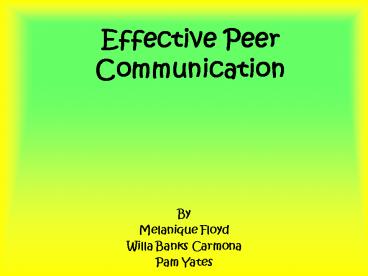Effective Peer Communication - PowerPoint PPT Presentation
1 / 20
Title: Effective Peer Communication
1
Effective Peer Communication
- By
- Melanique Floyd
- Willa Banks Carmona
- Pam Yates
2
Communication
- No one would talk much in society if they knew
how often they misunderstood others. - Johann Wolfgang Von Goethe
3
Many of the problems that occur in an
organization are the direct result of people
failing to communicate.
Communication is the exchange and flow of
information and ideas from one person to
another. Effective communication occurs only if
the receiver understands the exact information or
idea that the sender intended to transmit.
4
The Communication Process 1. Thought-
First, information exists in the mind of the
sender. This can be a concept, idea,
information or feelings.2. Encoding Next a
message is sent to a receiver in words or other
symbols. 3. Decoding Lastly, the
receiver translates the words or symbols into a
concept or information that he or she can
understand.
5
Barriers to Communication
Cultural background and bias Noise Ourselves Perce
ption Message Environmental Smothering Stress
6
Effective E-mail Your e-mails should be clear
and concise. Sentences should be kept short and
to the point.
Writing Skills Communicating through words can
be more concrete than verbal communications, with
less room for error and even less room for
mistakes.
7
Seven Ways to Improve Nonverbal Communication
- Eye Contact
- Facial Expression
- Gestures
- Posture and Body Orientation
- Proximity
- Voice Modulation (Paralinguistics)
- Humor
8
Eye Contact
- Eye contact with audiences increases the
speakers credibility. - Teachers who make eye contact open the flow of
communication and convey interest. - Interpersonal communication helps regulate the
flow of communication.
9
Facial Expression
- Smiling is a powerful cue that transmits
- Happiness
- Friendliness
- Warmth
- Liking
- Affiliation
10
Paralinguistics
- Tone
- Pitch
- Rhythm
- Timbre
- Loudness
- Inflection
- Students report that they learn less and lose
interest more quickly when listening to teachers
who have not learned to modulate their voices.
11
Gestures
- If you fail to gesture while speaking, you may be
perceived as boring, stiff, and unanimated. - A lively and animated teaching style captures
students attention, makes the material more
interesting, facilitates learning, and provides a
bit of entertainment. - Head nods, a form of gesturing, communicate
positive reinforcement to students and indicate
that you are listening.
12
Posture and Body Orientation
- You communicate numerous messages by the way you
walk, talk, stand, and sit. - Standing erect, but not rigid, and leaning
slightly forward communicates to students that
you are approachable, receptive, and friendly.
Speaking with your back turned or looking at the
floor or ceiling should be avoided it
communicates disinterest to your class.
13
Proximity
- Rocking
- Leg swinging
- Tapping
- Gaze aversion
- You should move around the classroom to increase
interaction with your students. Increasing
proximity enables you to make better eye contact
and increases the opportunities for students to
speak.
14
Humor
- Humor is often overlooked as a teaching tool.
- Laughter releases stress and tension for both the
student and teacher. - It fosters a friendly classroom environment that
facilitates learning.
15
Research shows that an effective peer mediation
program can reduce fights, discipline referrals,
suspensions, and can increase positive school
climate, teachers time teaching, and students
time learning.Leigh Jones-BammanProgram Manager
for the Governors Prevention Partnership
16
Benefits of Peer Mediation Programs
- provides a safe structure for people to solve
their problems and negotiate - improves communication among students,
administrators, teachers, and staff members - makes people more comfortable talking to someone
their own age who understands their concerns and
their perspective - peers are less threatening to talk to than
authority figures and this promotes honesty and
willingness to collaborate - people learn that they have to listen to others
point of view - helps people learn to live in a multicultural
world
17
Creating and Sustaining Collaborative
Relationships Among Teachers
- Collaboration provides teachers with a vehicle
for sharing a common knowledge base and vision.
Yet few teachers are using collaboration on a
regular basis as part of their work.
18
Collaboration allows teachers to
- Develop a sense of community
- Improve the quality of their teaching by working
together on unit plans, lessons and assessments - Recognize and appreciate diverse talents
Teachers who work autonomously have found it
difficult to modify their lessons and
instructions to reach the varied and changing
needs of their students. Think of some ways you
can collaborate with the teachers on your team.
19
Researchers have indicated that two components
are necessary when building a collaborative
relationship
- It needs to take place with an equal relationship
among all parties. - All parties must make a commitment to engage in
dialogue and mutual inquiry. Each participant
must have opportunities to experience each
others knowledge and expertise (Ferrara, 2000).
20
Conclusion
- Building new relationships, whatever the
circumstances, takes time rebuilding
relationships in which trust has been damaged can
take far longer (Young, 1998). If we hope to make
meaningful, lasting change within school
communities, establishing trust as a priority and
taking the time to develop it looks to be well
worth the investment. Without trust, a school
cannot improve and grow into the rich, nurturing
microsociety needed by adults and children
alike.(Blase and Blase 2001)

